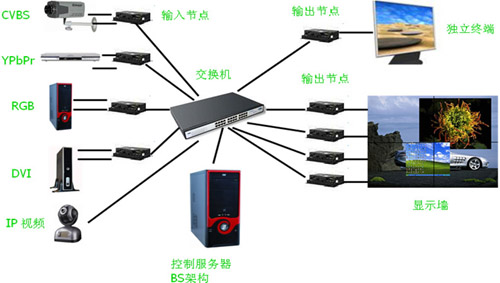With the continuous development of society, no matter in life or work, people's demand for the display of various information is increasing. The industry analysts believe that the future world is a visual world, which greatly promotes the large-screen splicing system. application. At present, large-screen splicing systems are playing an irreplaceable role in the fields of exhibitions, news centers, public security transportation, power dispatching, flood prevention and disaster relief, and military combat command centers.
The splicing processor is the core of the large-screen splicing wall technology. Its main function is to divide a complete image signal and assign it to each video display unit to complete the signal processing of using a large number of ordinary video units to form a large-screen dynamic image display screen. jobs. The traditional processing method in the current market is to collect and process all input, zoom-in, zoom-out, cutting, roaming, and output of all video signals, and all are handled by a single image processor, which is a centralized control method. The way will cause the processor to be overloaded, which increases the instability of the system. At the same time, there are certain restrictions on the types of signals that can be displayed and the processing capabilities.
However, with the continuous advancement of informatization, power, telecommunications, rail transit, railways, civil aviation, military construction, etc. have more and more demand for large-screen displays, and users need to centrally display, monitor, and manage information on large-screen mosaic walls The number and types are increasing day by day, and the scale of the video wall is also increasing with the increase of the number of signal source access. This leads to the increasing workload of the multi-screen processor of the video wall, and the large-screen display system faces new Challenge, traditional centralized signal processing can no longer meet the requirements.
The GQY distributed network image processing and display system is based on the shortcomings of traditional controllers and new market development trends. The new generation of GQY splicing controllers distributes the load of the system. The distributed network image processing system combines video and computer RGB. The signal collection, processing and display are dispersed in different processing units, and synchronized real-time processing is carried out under the unified management control of the control unit to complete the information processing tasks in a coordinated manner. The use of distributed processing technology not only meets the needs of access and real-time display of large amounts of data and multiple signal sources, but also greatly reduces the load on the processor. The overall performance and transmission speed of the processor have been greatly improved, realizing the user system The optimal optimization of resources fundamentally guarantees the display security and stability of user application systems.
GQY distributed network image processing display system application topology diagram:

Functional advantages of GQY distributed network image processing and display system solutions
1. Front-end HDMI input node:
Front-end access signal type: support VGA / DVI / HDMI / YPbPr / CVBS;
Number of signals simultaneously connected to the front end: all types of signals are simultaneously connected to the second channel;
2. Back-end output node:
Rear output signal type: support DVI / HDMI;
Number of simultaneous output signals at the back end: all kinds of signals are output simultaneously at the same time;
3. Adopt H.264 compressed video transmission, reduce network data traffic, do not make any proportion transformation to the image to ensure the originality of the image;
4. Complete real-time processing and transmission, the entire transmission and processing delay is less than 50ms;
5. One node can process 2 ~ 4 channels of video, and one network cable can transmit 2 ~ 4 channels of video, greatly reducing the wiring cost and complexity;
6. Support full HD 1080P / 60Hz compression and transmission, DVI and RGB can support 1920 * 1080 * 60Hz;
7. Cooperate with our DLP built-in image processor or DID built-in image processor to realize 2 ~ 3 window display.
GQY distributed network image processing and display system overcomes the limitations of traditional centralized control large-screen splicing display system control signals and processing capabilities, and will bring revolutionary changes to the application field, becoming the most advanced and safe field of large-screen display today. Signal processing method. The application of GQY distributed network image processing system in the field of large screen splicing truly caters to the development trend of the market and will bring unprecedented benefits to the entire industry.
Taihe Fangyuan Muye Co.,Ltd , https://www.fangyuanfurniture.com